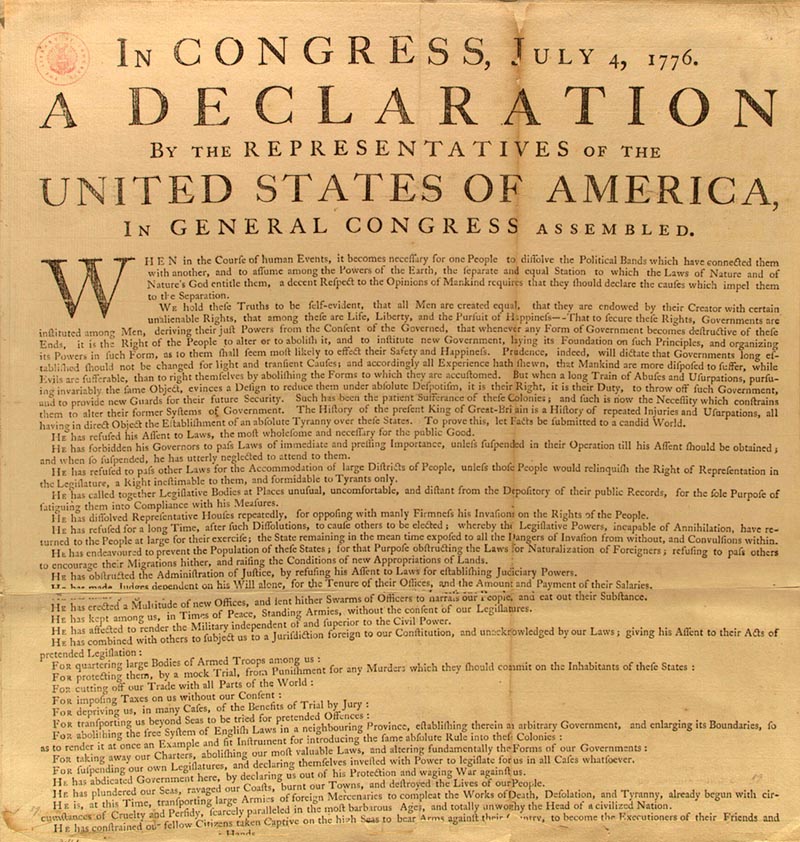|
Moderated by NW Okie! |
Volume 13 , Issue 272011Weekly eZine: (374 subscribers)Subscribe | Unsubscribe Using Desktop... |
Declaration of Independence (235 Years Ago)

"We hold these truths to be self-evident, that all men are created equal, that they are endowed by their creator with certain unalienable Rights, that among these are Life, Liberty and the pursuit of Happiness."
The above quote was taken from the Declaration of Independence, which was drafted by Thomas Jefferson between June 11 and June 28, 1776. Jefferson expressed the convictions in the minds and hearts of the American people. The political philosophy of the Declaration was nothing new. Its ideals of individual liberty had already been expressed by John Locke and the Continental philosophers. Jefferson summarized this philosophy in "self-evident truths."
Did you know that the oldest signer of the Declaration of Independence was none other than that famous signer, Benjamin Franklin. Franklin was born 17 January 1706 and was 70 years old at the time of the signing. In a close second place behind Franklin was Stephen Hopkins (born 7 March 1707) of Rhode Island.
The 56 signatures on the Declaration appear in the positions indicated below. During your Ancestry research, have you found a connection to one of these "Founder Fathers?"
- Column 1, Georgia: Button Gwinnett; Lyman Hall; George Walton; Column 2, North Carolina: William Hooper; Joseph Hewes; John Penn; South Carolina: Edward Rutledge; Thomas Heyward, Jr.; Thomas Lynch, Jr.; Arthur Middleton;
- Column 3, Massachusetts: John Hancock; Maryland: Samuel Chase; William Paca; Thomas Stone; Charles Carroll of Carrollton; Virginia: George Wythe; Richard Henry Lee; Thomas Jefferson; Benjamin Harrison; Thomas Nelson, Jr.; Francis Lightfoot Lee; Carter Braxton;
- Column 4, Pennsylvania: Robert Morris; Benjamin Rush; Benjamin Franklin; John Morton; George Clymer; James Smith; George Taylor; James Wilson; George Ross; Delaware: Caesar Rodney; George Read; Thomas McKean;
- Column 5, New York: William Floyd; Philip Livingston; Francis Lewis; Lewis Morris; New Jersey: Richard Stockton; John Witherspoon; Francis Hopkinson; John Hart; Abraham Clark;
- Column 6, New Hampshire: Josiah Bartlett; William Whipple; Massachusetts: Samuel Adams; John Adams; Robert Treat Paine; Elbridge Gerry; Rhode Island: Stephen Hopkins; William Ellery; Connecticut: Roger Sherman; Samuel Huntington; William Williams; Oliver Wolcott; New Hampshire: Matthew Thornton
It was on July 4, 1776, the 2nd Continental Congress met in Philadelphia in the Pennsylvania State House (Independence Hall) to approve the Declaration of Independence, which severed the colonies ties to the British Crown. Let us go back to a few days before the July 4, 1776 with a timeline of events.
- June 7, 1776 - Richard Henry Lee introduced a resolution urging congress to declare independence from Great Britain.
- June 11, 1776 - Thomas Jefferson, John Adams, Benjamin Franklin, Roger Sherman, and Robert R. Livingston were appointed to a committee to draft a declaration of independence.
- June 28, 1776 - A fair copy of the committee draft of the Declaration of Independence was read in congress.
- July 1-4 - congress debated and revved the Declaration of Independence
- July 2, 1776 - congress declared independence by adopting the Lee Resolution.
- July 4, 1776 - congress adopted the Declaration of Independence. Congress ordered that the Declaration of Independence be printed (Dunlap Broadsides).
- July 19, 1776 - congress ordered the Declaration of Independence engrossed (officially inscribed) and signed by members.
- August 2, 1776 - The engrossed copy of the Declaration of Independence was signed by most of the delegates. Elbridge Gerry, Oliver Wolcott, Lewis Morris, Thomas McKean, and Matthew Thornton all signed on a later date.
See The Library of Congress for more information and documents from the Continental Congress and the Constitutional Convention, 1774-1789. | View or Add Comments (0 Comments) | Receive updates ( subscribers) | Unsubscribe
| © . Linda Mcgill Wagner - began © 1999 Contact Me | |
